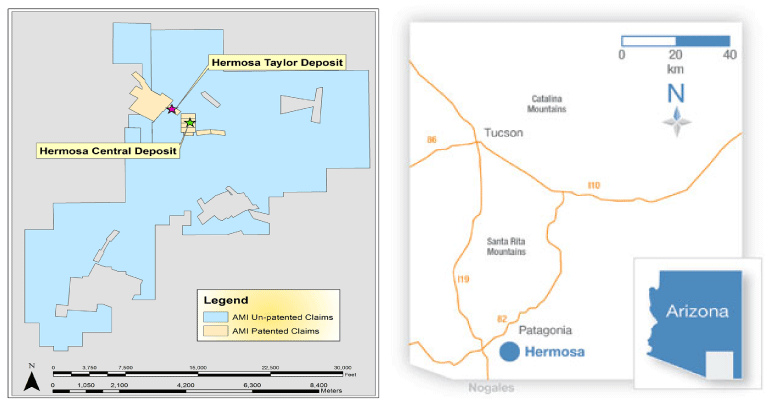
Arizona Mining Inc. (formerly Wildcat Silver) has just announced a major new discovery of zinc-lead-silver mineralization on their Hermosa Taylor project in Santa Cruz County near Patagonia, Arizona.
I have previously reported on what is now called the Hermosa Central deposit which lies to the southeast of the new deposit: see Manganese may be mined in Arizona. According to a prefeasibility study completed in December, 2013, that deposit contains reserves of 145 million ounces of silver and 7.2 billion pounds of manganese, with inferred additional resources of 235 million ounces of silver and 10.3 billion pounds of manganese. The mineralization occurs mainly as a oxide manto (blanket).
The new discovery, called the Hermosa Taylor deposit, discovered in 2015, lies about 2,000 feet to the northwest of Hermosa Central. This mineralization is a stratabound carbonate replacement deposit. This deposit contains sulfides of zinc, lead (with silver) and copper. A resource estimate as of Feb., 2016, claims 39.4 million ton of 11.04% zinc equivalent. (An “equivalent” grade adds in prorated values for copper, lead and silver, see chart here.) There is also an overlying oxide zone according to the cross-section (see here).
Arizona Mining reports that the best hole to date at Taylor Deposit HDS-361 intersects 8 mineralized intervals including 105 feet grading 13.65% Zinc, 10.33% Lead and 3.36 opt Silver and 73 feet grading 15.20% Zinc, 11.20% Lead and 3.89 opt Silver within a larger interval of 504.5 feet grading 6.51% Zinc, 4.88% Lead and 1.72 opt Silver. (Opt = ounces per ton)
The new Taylor deposit remains open to the north, west, and south, so the actual resource could be much bigger than currently estimated. See exploration potential map here.
Update, September 13: Arizona Mining reports that a step-out hole sited 1,300 feet northwest of the existing resource encountered intense alteration and recrystallization of the carbonate host and five distinct mineralized intervals including a 24.5 foot interval which assayed 23.1% zinc, 13.5% lead, 0.10% copper and 7.3 ounces per ton silver within a 49.5 foot thick broader zone of mineralization which assayed 13.6% zinc, 8.04% lead, 0.11% copper and 4.79 opt silver. This result bodes well for the possibility of greatly expanding the resource.
Both the Central and Taylor deposits are hosted by Paleozoic sandstones and limestones and by Cretaceous and Tertiary volcanic rocks. See here for more detail.
Arizona Mining’s current interpretation of the geology:
The major lithologic host for the Hermosa deposit is an epiclastic sandstone that is locally interbedded with very fine-grained tuff. High-angle faults, trending predominantly north-south and east-west, bound the horst blocks in the area, and may have served as conduits for mineralizing fluids.
Sections through the deposit oriented both east-west and north-south suggest that the strata are deformed into a doubly-plunging anticline the apex of which is coincident with the highest grade-thickness of silver accumulation, which suggests that deformation pre-dated the mineralizing event, that mineralizing fluids migrated to the topographically highest permeable area, and that post-mineral tilting of the deposit has occurred.
The company still has more drilling and metallurgical testing to do, but that’s the easy part. The hard part is navigating the regulatory quagmire for permitting.
Note to readers:
- Index with links to all my ADI articles: http://wp.me/P3SUNp-1pi
- My comprehensive 28-page essay on climate change: http://wp.me/P3SUNp-1bq

